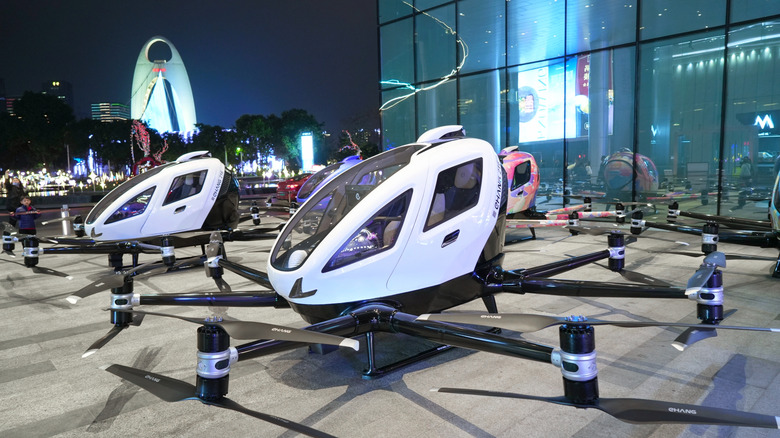Flying Taxis Are No Longer Science Fiction: Here's What Travelers Need To Know
It's safe to say that most of us have dreamed of flying cars. Maybe we watched a rerun of "The Jetsons" and thought, "I want to zip around in one of those levitating vehicles, just like George." Perhaps you watched Doc Brown whiz through high-altitude traffic in "Back to the Future II" and fantasized about your own gravity-defying DeLorean. For the past century or so, futurists have promised us everything from jetpacks to hoverboards, and generations have fawned over the idea of commuting through the air.
It seems that the future is now: Dubai, the hyperactive desert city in the United Arab Emirates, is expected to launch flying taxis as early as 2026. The prototypes look much like camera drones, the kind you would use to capture amazing aerial footage for a travel video, except large enough to fit passengers. The city is currently testing its prospective commercial taxi service and developing a system of "vertiports," where the vehicles will take off and land. The technology is the brainchild of Joby Aviation, a company based in Santa Cruz, California, in collaboration with the Dubai Roads and Transportation Authority. The new taxi should be one of the many amazing things you need to see (and do) in Dubai.
The city plans to start with four vertiports. The taxis will use electric engines and drone-like propellers. Most astonishing of all, passengers won't meet pilots onboard; operators will fly the taxi remotely, making the vehicle seem completely autonomous.
Dubai: a flying taxi testing ground?
Dubai is a natural fit for this new technology: the city is already home to a sophisticated metro system (which is also driver-less), the spectacle-infused Dubai Mall, and hundreds of glittering skyscrapers. Although the UAE is respected around the world for its high quality roads, the city is actively struggling with traffic, and even its formidable public transit system — incorporating more than 1,500 buses — can't ease congestion. A possible solution is this aerobatic cab, although it's hard to say exactly how much a ride will cost. Presumably, only well-heeled travelers will levitate over the city's skyline, much the way wealthy tourists can get around Italy in a unique and thrilling way with this transportation method.
But what if it works? There's a lot to like about flying taxis: they remove cars from the road, their engines leave a negligible carbon footprint, and they couldn't possibly be louder or more obnoxious than helicopters, a common sight in Dubai's airspace. The absence of a physical pilot means passengers may feel a certain amount of privacy. if demand is strong enough, four vertiports could theoretically expand into many more; if there's one thing Dubai isn't afraid of, it's building new infrastructure.
Meanwhile, other countries are aggressively flirting with the concept too. In October 2025, air taxis made a dramatic cameo at the Salinas Airshow in California. The company Ehang hopes to launch autonomous flying taxis in major Chinese cities by 2028. Will this be a passing curiosity? A fad for corporate muckety-mucks? Or will flying taxis herald a new era in transportation? All eyes are now on Dubai. If you're planning a visit, here are Dubai's most glamorous hotels, according to travelers.

